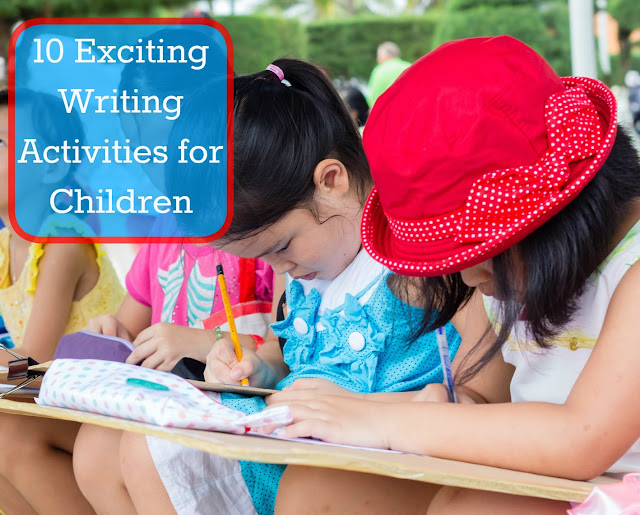10 Exciting Writing Activities for Children
Today we are joined by guest blogger Alyssa Johnson, she has some great suggestions for fun writing activities to use with children.
Children of school age and younger require a special approach to education. This is especially important when you are trying to teach your child how to read and write, as these are basic skills that every kid should possess. In fact students perceive the information much more effectively - if it is provided in the form of didactic game. This is one of the most effective methods for improving the child’s cognitive skills.
In this article, we will talk about engaging writing activities. Interesting writing assignments for kids will allow them not only to develop their writing skills, but also learn the rules of spelling, develop attention, logic, memory, and logical thinking.
What Benefits Such Interesting Educational Activities Give?
While playing such fun creative writing games, students also acquire qualities such as patience, perseverance, punctuality, which will undoubtedly help them in the future and will contribute to raising academic performance in high school. The competitive moment in these activities is also important. This way, a child wants to stand out, and his performance improves because he is trying to complete quests faster, neater and better than others. Thus, it is recommended to arrange group lessons.
If you are teaching your child at home, look for some interesting kids' writing ideas that would help you to create a fun but useful didactic game. There are many exercises online that will be of interest to your children. Thus, if you don’t have enough time, this can be a suitable option for you.
What to do if your elder kids require improving their writing skills? In this case, writing under dictation is the best practice; you can take a text from the internet or visit this page to order any text on the preferred subject.
What exercises to use? To help you get started, we have selected the best creative writing exercises for kids, try to use them while studying at home, and you will see how effective they are!
Exercise 1
To prepare for this game, you’ll need to make some printable cards. Each of these cards should contain a set of random letters. Hand out the cards to every kid and ask them to form as many meaningful words from these letters as they can. These sets can consist of a different quantity of letters. For example, it is enough to provide 3-4 letters for preschoolers and first-grade students, while older students can cope with more complex tasks.
Exercise 2
Take a few sheets of paper and print different images on them. It can be furniture, animals, plants, household items, etc. Place these images on each sheet in such order, so that the initial letters would form words, using which, kids could make logical sentences.
Exercise 3
Provide several words of 3-4 letters. The point of this exercise is to ask students to create new words by replacing one letter in in the word they were given and write these words down, underlining the letter that they changed.
Exercise 4
Provide children with a few words, consisting of 3-5 letters, and have them make other words using the same set of letters.
Exercise 5
Take a few cards with an illustration of words that are opposite in meaning. For example, fat, skinny, dirty, clean, etc. Ask students to find suitable pairs and match each picture with the adjective that describes it; this will help your kids to learn more adjectives and improve logical thinking.
Exercise 6
Provide words that have to be combined in accordance with the rules of grammar. For example, write down “watch” and “look” in column №1, and make another column with words like “a movie,” “for someone” next to it, and ask students to combine them.
Exercise 7
Give students some words and ask them to find synonyms.
Exercise 8
Find encrypted words – provide several lengthy words and ask kids to find “hidden” words inside of them.
Exercise 9
Make cards with the words that are missing some syllables or letters and ask children to correct them (for example, W_nt_r – winter, and other).
Exercise 10 (suitable for kids who are reading and writing confidently)
Write down words with obvious errors and let the children find and correct these mistakes. To get started, you can write your child’s name; he will find a mistake with joy and gain interest in a game.
Don't forget to praise and encourage children for their achievements!
Children of school age and younger require a special approach to education. This is especially important when you are trying to teach your child how to read and write, as these are basic skills that every kid should possess. In fact students perceive the information much more effectively - if it is provided in the form of didactic game. This is one of the most effective methods for improving the child’s cognitive skills.
In this article, we will talk about engaging writing activities. Interesting writing assignments for kids will allow them not only to develop their writing skills, but also learn the rules of spelling, develop attention, logic, memory, and logical thinking.
What Benefits Such Interesting Educational Activities Give?
While playing such fun creative writing games, students also acquire qualities such as patience, perseverance, punctuality, which will undoubtedly help them in the future and will contribute to raising academic performance in high school. The competitive moment in these activities is also important. This way, a child wants to stand out, and his performance improves because he is trying to complete quests faster, neater and better than others. Thus, it is recommended to arrange group lessons.
If you are teaching your child at home, look for some interesting kids' writing ideas that would help you to create a fun but useful didactic game. There are many exercises online that will be of interest to your children. Thus, if you don’t have enough time, this can be a suitable option for you.
What to do if your elder kids require improving their writing skills? In this case, writing under dictation is the best practice; you can take a text from the internet or visit this page to order any text on the preferred subject.
What exercises to use? To help you get started, we have selected the best creative writing exercises for kids, try to use them while studying at home, and you will see how effective they are!
Exercise 1
To prepare for this game, you’ll need to make some printable cards. Each of these cards should contain a set of random letters. Hand out the cards to every kid and ask them to form as many meaningful words from these letters as they can. These sets can consist of a different quantity of letters. For example, it is enough to provide 3-4 letters for preschoolers and first-grade students, while older students can cope with more complex tasks.
Exercise 2
Take a few sheets of paper and print different images on them. It can be furniture, animals, plants, household items, etc. Place these images on each sheet in such order, so that the initial letters would form words, using which, kids could make logical sentences.
Exercise 3
Provide several words of 3-4 letters. The point of this exercise is to ask students to create new words by replacing one letter in in the word they were given and write these words down, underlining the letter that they changed.
Exercise 4
Provide children with a few words, consisting of 3-5 letters, and have them make other words using the same set of letters.
Exercise 5
Take a few cards with an illustration of words that are opposite in meaning. For example, fat, skinny, dirty, clean, etc. Ask students to find suitable pairs and match each picture with the adjective that describes it; this will help your kids to learn more adjectives and improve logical thinking.
Exercise 6
Provide words that have to be combined in accordance with the rules of grammar. For example, write down “watch” and “look” in column №1, and make another column with words like “a movie,” “for someone” next to it, and ask students to combine them.
Exercise 7
Give students some words and ask them to find synonyms.
Exercise 8
Find encrypted words – provide several lengthy words and ask kids to find “hidden” words inside of them.
Exercise 9
Make cards with the words that are missing some syllables or letters and ask children to correct them (for example, W_nt_r – winter, and other).
Exercise 10 (suitable for kids who are reading and writing confidently)
Write down words with obvious errors and let the children find and correct these mistakes. To get started, you can write your child’s name; he will find a mistake with joy and gain interest in a game.
Don't forget to praise and encourage children for their achievements!
Alyssa Johnson is a blogger and freelance writer. She lives under the credo "Education is the most powerful weapon which you can use to change the world."








Comments
Post a Comment